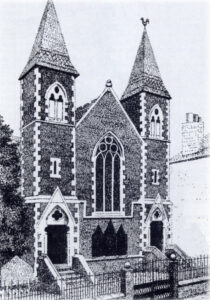 The second Bethesda Chapel in River Street, Truro
The second Bethesda Chapel in River Street, Truro
For many years Bethesda Chapel occupied a prominent position in Truro. Two buildings in River Street carried the name, the first before the street was created, when the River Kenwyn ran past its “front door”. This is the story of those chapels but their history would not be complete without both the lead up to their construction or their fate after they had ceased to be a place of worship. Tony Mansell brings us the story of those buildings and the folk who worshipped in them.
Bethesda was built by and for those who termed themselves Independents. It was later known as Truro Congregationalist Chapel but as these names are interchangeable, it is difficult to decide whether or not this change was a conscious decision or a natural progression. Perhaps someone will be able to clarify this.
According to the Encyclopaedia Britannica the Independent/Congregationalist movement arose in England in the late 16th and 17th centuries. It occupies a theological position somewhere between Presbyterianism and the more radical Protestantism of the Baptists and Quakers. It emphasizes the right and responsibility of each properly organized congregation to determine its own affairs, without having to submit these decisions to the judgment of any higher human authority, and as such it eliminated bishops and presbyteries. Each individual church is regarded as independent and autonomous.
Together with the Presbyterians, Baptists and others, its members were classed as dissenters – those not conforming to the state church. John Wesley insisted that the Methodists were not dissenters, no doubt because during his lifetime they remained within the Anglican Church.
When talking of the Independents it is possible, although by no means certain, to refer to the early name for the Congregationalists but as other sects claim to be independent, that is independent of the Church of England, the situation is often unclear. So, the use of the word Independent in respect of religious bodies causes a problem for the historian, perhaps especially this historian, and because of this it is difficult to say exactly when Congregationalism first came to Truro. Richard Ball, in Congregationalism in Cornwall, states that the movement became established there in 1761 but he also refers to an earlier group in Truro with a “non-conformist congregation with Presbyterian leanings”. This could well have been a Congregationalist type group especially as it was referred to in the Congregational Magazine of that time.
The Truro Buildings Research Group refers to a congregation with a meeting house in Kenwyn Street, built in 1708 on a site reached through a court which is now the William IV beer garden, and this could be the one mentioned by Richard Ball. The congregation’s last minister was Peter Kello whose ministry, according to the Congregational Magazine, “…trumpeted an uncertain sound as having little of the unction those who sat under Samuel Walker’s ministry had been accustomed to enjoy and was far from offering them the satisfaction they needed”. More about the Reverend Samuel Walker follows but it is clear that this early church probably closed either during or soon after his tenure in Truro. Other comments state that “the church was in a very enfeebled condition and went out” and, as far as we can tell, the Baptists opened a chapel in this building in 1789.
So, we are left to wonder if this Kenwyn Street Meeting House was a part of the Congregationalist movement, Presbyterian or independent of all formal religious bodies?
The Reverend Samuel Walker
Without doubt, the Reverend Samuel Walker contributed hugely to the rise of a new independent movement in Truro. He was the curate at St Mary’s Anglican Church from 1746 to 1760 and his popularity and evangelical services attracted many members including some from the old Kenwyn Street Church.
Richard Polwhele wrote that when Walker came to Truro, it was a place of “dissipation, notorious for its worldliness and frivolity”. That changed as he formed a Methodist type Society within the Anglican Church and introduced a strict code of conduct and was quick to disqualify members if they did not follow them. In many ways he was as strict as the early Methodists but, to his credit, he is said to have abolished cockfighting1 and reduced drunkenness in Truro. Indeed, no history of Truro Independents or Congregationalists, or of their Bethesda Chapel, would be complete without acknowledging the influence of the Reverend Samuel Walker.
Writing in the 1750s, the Independent Minister, the Reverend Risdon Darracott of Penzance wrote: “The Reverend Samuel Walker of Truro whose evangelical and teaching ministry at St Mary’s Parish Church was attracting a widening and discerning circle of admirers”.
Although Walker was not a Methodist, John Wesley, one of the founders of the Methodist movement, consulted him on various matters including the question of separation from the Church of England. Both were committed to working within the Anglican Church. It seems that that they met on occasion and that Wesley supported him including by refusing to set up a Methodist sect in Truro during Walker’s time there.
Walker appears to have been an elegant preacher and indefatigable worker, holding extreme Calvinist2 views. The story is told that he refused to read the whole of the burial service over one of his parishioners who had led a very dissipated life. This gave great offence to many in his congregation and led to complaints being made to the bishop. He formed a close association with Selina Hastings of Lady Huntingdon’s Connexion3, and it seems that their ministers later preached at the Independent’s chapels.
For a fuller picture of the Reverend Samuel Walker we can do no better than turn to an article by Cornish historian, Ashley Rowe, writing in the West Briton and Cornwall Advertiser of Monday the 26th March 1956.
Samuel Walker the Preacher
Samuel Walker’s chief studies at Oxford had been in logic. His preaching showed the effect of this. He made no appeal to the emotions: we do not read of crowds affected by tears, or of being made hysterical by hymn-singing. His emphasis was on the conviction of sin and the necessity for repentance. He reproved the formalist equally with the openly evil-liver; Edwin Sidney says he “proclaimed that the profane, the lustful, and the formalist were all marching with the multitude on the same broad road to destruction”. His sincerity and example had its effect on the people. who, “while they were enraged at the fidelity, were enchained by the eloquence, and trembled at the sternness of their reprover”. His manner is said to have been commanding and solemn in the extreme, even out of the pulpit his parishioners feared the presence of their minister. Sidney says: “The Sabbath loiterers would retire at his approach. Saying, ‘let us go, here comes Walker’”. The example of his life was in complete unison with his preaching, even those who resented his grouping them with the sinful and unbelievers were awed into silence. The church was full, the thoroughfares of the town seemed to be deserted during the hours of service, so that it was remarked “you might fire a cannon down every street of Truro in church time without a chance of killing a single human being”. It is said that so great was the effect of Walker’s sermons that the theatre and cockpit were deserted and forced to close and did not reopen while he remained in Truro. This is the earliest mention of a theatre in Truro, and there is no corroboration; it is possible that it was merely a rhetorical statement by the biographer. The cockpit certainly did exist and was standing until the close of the 19th century, when it was in use as a wheelwright’s shop. By a curious coincidence that disused cockpit, after Walker’s death, became the meeting place of Walkers followers or disciples, as they were termed. This gave rise to the name Cockpitarians. These same people later built Bethesda Chapel in River Street, now the offices of Truro Rural District Council. Walker’s teaching was not confined to the pulpit, large numbers of people came to him for private instruction and he rented two rooms which were set aside for this. Here, again, he eschewed emotion, drawing up a definite scheme of private instruction to which he rigidly adhered. By 1754, when Walker had been seven years at Truro, the number of people under instruction became too great for the limited circle of private advice and personal attention, and he decided to form his converts into a religious society.
In February 1754 Walker laid a scheme for the society before his people. He laid down three points as a foundation: “the design is threefold – to glorify God – to quicken and confirm ourselves in faith and holiness – and to render ourselves more useful among our neighbours”. Very strict rules were drawn up by Walker; the meetings were to be held once a week and were to end at 9:00 o’clock, “whoever absence himself, if four meetings together, without giving satisfactory reason to the Society, shall be looked upon as disaffected to it”. Members might also be removed for disorderly carriage: this was defined as “not only the Commission of gross and scandalous sins, but also what are esteemed matters of little moment in the eyes of the world… the buying and selling of goods which have not paid custom”. The doing of needless work on the Lord’s day. The frequenting ale houses or taverns without necessary business. Here in very definite evidence of the light view that was taken by the public of smuggling and of dealing in smuggled goods – “matters of little moment”. There were actually two societies, one for married men, the other for single. There was no separate society for women but wives and older women were admitted to the married men society. No single men were admitted to this society. The meetings of these societies were presided over by Mr Walker alone, and he reserved himself the soul performance of the devotional exercises. In addition to weekly meetings, small groups were formed to meet regularly at their own convenience to “converse freely upon their trials, consultations and experience”. A rule was that there were never to be less than five present nor more than eight. Walker did not attend these gatherings, but he drew up for their guidance a little treatise called “Regulations and Helps for promoting religious conversation among Christians”. He also turned his attention to the young people and children – this was before the days of Sunday schools – and restored the long disused practise of catechising. The young people were divided into three classes – under 12, between 12 and 15 and between 15 and 20. They were instructed in private, and then catechised in the church, “an hour after sermon”, before an audience sometimes amounting to 500 people who were “for the most part much impressed”. One hardly knows which to admire most, the minister’s passion for work, or the hardiness of the congregation.
One cannot but realise that St Mary’s Church, two centuries ago was the most vital force in Truro. In November 1756, three companies of soldiers were sent to Truro for winter quarters. Walker writes of his efforts: “I endeavoured to lose no time with them, but without delay preached a sermon extraordinary on the Sunday afternoon called by the people here, the Soldiers’ Sermon. There was great difficulty to get their attendance to hear it. For though they may be ordered to be at church in the morning, and are brought thither by their officers, yet their manner has been to take off at the door”. This was exactly 200 years ago: probably much the same result would happen today. Walker’s society members made personal contacts with the soldiers and got them to attend the services in less than three weeks, says Walker, “a full hundred of them came to my house” seeking instruction. There was at first a certain amount of official opposition, the captain publicly for bade his men to attend private instruction, but it soon became apparent that good work was being done. Punishment decreased, and order prevailed in the regiment, to a large degree never before witnessed. “The officer waited on Mr Walker in a body… to thank him for the reformation he had produced”. This party left Truro after nine weeks stay. They were followed by others, amongst whom Walker continued to work.
Samuel Walker’s great influence while he was in Truro is undoubted but as events transpired, that influence extended beyond the grave and led to the eventual construction of Bethesda Chapel, an important religious edifice in which many of Truro’s citizens worshipped.
Samuel Walker died at Blackheath on the 19th July 1761, the year after he had left Truro. His successor at St Mary’s was the Reverend Charles Pye, a staunch anti-Calvinist. Parson Pye, it was said, was a man of a very different stamp and his comments about his predecessor, and his contrasting nature, caused great concern amongst Walker’s followers. Much later, Michael Whitley writing in the Royal Cornwall Gazette of Friday the 29th October 1880, quoted him as saying: “My Pulpit has been pretty well purified from Calvin, a strong fumigation was no more than needed”.
Within a short time the differences between the Reverend Pye and Walker’s followers reached breaking point and in 1761 the group left the Anglican Church to form Truro’s first Independent Church body or, as it became known, The Disciples of the Reverend Samuel Walker. (The comment that it was Truro’s first Independent Church body suggests that the Kenwyn Street society was related to a formal religious body)
For a while the group seem to have been nomadic and met where they could, including in a place referred to as John Painter’s room, a man who seems to have been a member of the breakaway congregation.
The Cockpitarians or Walkerites
It was clear that this new church had no intention of returning to the fold of the Anglican Church but to prosper, it needed premises, a chapel where its adherents could meet. In 1769, it leased the old cockpit in Tippett’s Backlet, in the Leats. It opened on the 24th March 1769 and because of its former use, members of the congregation were often referred to as Cockpitarians and taunted in the streets by people flapping their arms imitating cockerels. Registering it as a dissenting meeting house was initially delayed due to an objection raised by the Reverend Pye who alleged that the applicants were Methodists. An appeal was made on the basis that it was not Methodist, but an Independent Congregation of Protestant Dissenters. This was accepted with apologies and the building was duly registered.
Kresen Kernow comments, “The first official Independent Church [chapel] of Truro began 25th April 1770 under its first minister, the Reverend Peter Sampson, who remained there fifteen years”.
It should be noted that there was no mention of it being Congregational but as the Kenwyn Street chapel had probably closed by this time it is quite possible that its congregation and the Walkerites amalgamated either then or shortly after.
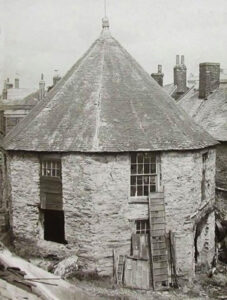 The Cockpit, an octagon shaped building in the Leats at the rear of the brewery, used for worship from 24th March 1769 to 1776. It is thought to have been demolished during the 1880s.
The Cockpit, an octagon shaped building in the Leats at the rear of the brewery, used for worship from 24th March 1769 to 1776. It is thought to have been demolished during the 1880s.
The Reverend Peter Sampson led the congregation of Independents through its formative years, but success often brings problems and within a short time they had outgrown the Cockpit and were in need of a larger chapel. The search began for suitable premises.
The books of the Truro Buildings Research Group state that in 1774 they “bought a plot in the eastern side of Matthew’s market garden which lay between the river and the leat”. The chapel, together with a house for the pastor, was to be built at the rear of the site, possibly facing the Leats. It should be appreciated that River Street was not constructed until circa 1840 and when the first Bethesda Chapel was built, it had the Leat on one side of its site and Kenwyn River on the other.
The 1776 Bethesda Chapel
The first Bethesda Chapel opened on the 10th June 1776 and the Truro Independent Church congregation vacated the old cockpit and moved the short distance to their new chapel.
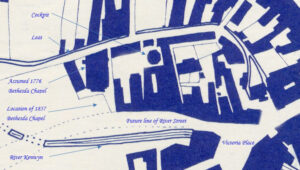 Symonds 1842 Map showing the cockpit and what appears to be, the 1776 Bethesda Chapel
Symonds 1842 Map showing the cockpit and what appears to be, the 1776 Bethesda Chapel
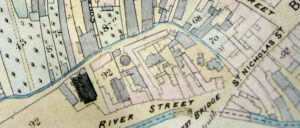 1842 Tythe Map with Bethesda (shaded)
1842 Tythe Map with Bethesda (shaded)
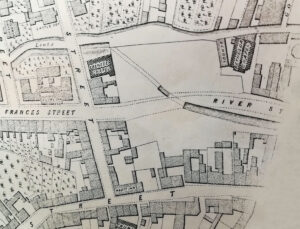
Bethesda was, or became, a Congregational Chapel but when and how that name was in use is not clear. Kresen Kernow records state that “Bethesda Chapel was Congregational and in 1835 stood behind what became the old Truro Rural District Council Offices”. The National Archives also states that “Bethesda Chapel was Congregational…” but this categorical statement provides no further details of when, or in what circumstances, the new, or alternative, name was adopted. As we have said, it appears that the Kenwyn Street chapel may have been Congregational, so did the Truro Congregational movement and the Independent Walkerites amalgamate to build the new church?

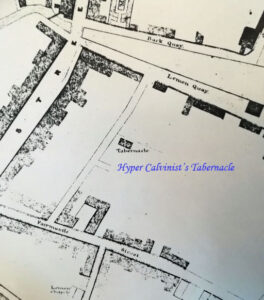 The Hyper Calvinist Chapel (map provided by Susan Coney)
The Hyper Calvinist Chapel (map provided by Susan Coney)
An interesting item in Truro in the Eighteenth Century by June Palmer, states that Gabriel Davy, who died in 1827, aged 91, was “the last survivor of a select society formerly known as the disciples of the Reverend Samuel Walker”.
The Royal Cornwall Gazette of Friday the 11th August 1837 included a notice, “That a Separate Building named the Bethesda Chapel, situate in River Street, in the parish of St Mary in the Borough of Truro, in the County of Cornwall, being a building certified according to Law as a place of religious worship, was on the 1st day of August 1837, duly registered for solemnizing Marriages therein pursuant to Act of 6th and 7th William 4th, cap. 85. Witness my hand this Fifth day of August 1837. R. M. Hodge, Superintendent Registrar”.
1837 – 25 September: Mr James John’s third daughter, Jane, married Mr Birrett, draper of London House, Truro, at the Bethesda Chapel. This was the first marriage to take place in a dissenting chapel in Truro under the Marriage Act 1836.
We do not know whether it was because of the increasing size of the congregation or the deterioration of the building, but by the 1850s, moves were afoot to build a larger chapel. By 1857 the first Bethesda Chapel was demolished to make way for a replacement.
The 1857 Bethesda Chapel
On Friday the 4th September 1857 the Royal Cornwall Gazette gave notice that the foundation stone of the new Independent Chapel was to be laid on the site of the old Bethesda Chapel in River Street, Truro, on the following Tuesday at 12.30pm. Mr Michell, the Mayor of Truro, was to undertake the ceremony and after, a public dinner was to be provided in the Council Chamber of the Town Hall. The charge for ladies was to be one shilling and six-pence, for gentlemen two shillings and for a lady and gentleman, it was three shillings. Sermons were to be preached at 11.00am in the Baptist Chapel, and at 7.00pm at the St Mary’s Wesleyan Chapel, by the Rev. W H Dyer, of Bath, successor to the late Rev. W Jay. Collections after each service would be in aid of the Building Fund. It is interesting to see other denominations supporting the building of what we may consider to be a rival chapel.
The ceremony was duly carried out with the memorial stone laid by the Mayor of Truro, Edward Michell. The Royal Cornwall Gazette of Friday the 11th September 1857 reported that the new building was to occupy the site of the old chapel, except that its front would extend further towards the recently created River Street. It must be borne in mind that less than 20 years earlier instead of this street, there was a river – the Kenwyn. The chapel, like its predecessor, was to be called Bethesda and its name, and its date, was cut in the granite memorial stone which had been positioned facing the street. Banners, flowers and evergreens were displayed and a platform erected extending from near the front wall and over the area of the building enclosure. The newspaper reported that when all things had been prepared for the ceremony, the Rev. Low (Wesleyan) gave out, and the assembly sang, a hymn from the Congregational Hymn Book: And will the great eternal God.
The Reverend Panks then announced that a hermetically sealed bottle containing a parchment was to be placed beneath the stone and Mr Sims, the Senior Deacon, read what was written on it:
“This Building, known as Bethesda Chapel, is erected on the site of an edifice built for the same object, Anno Domini 1774, for the worship of God, the preaching of the Gospel, and the administration of Christian ordinances in connection with that body of Protestant Dissenters called independents. This Memorial Stone is laid on the 8th day of September, Anno Domini 1857, by Edward Michell, Esquire, Mayor of this Borough; with earnest prayer that God himself will consecrate this sanctuary by his own presence, and bless the preaching of the Gospel therein, to the salvation of many souls. Rev. Robert Panks, Pastor. John Sim, John Paddon, John Whetter; Deacons. John Whetter, John Randall, William Trewolla, Henry L. Dunn, George Woolley, Nettleton Moore; Trustees. Robert Michell, Richard Barrett, James Tannahill, Thomas Solomon, Nettleton Moore, Edward Moore, J. Russell Endean, James Laidlaw, John McKenzie, William Norton, George Dixon; Committee. W. G. and E. Habershon, architects. John Clemens, Richard Stevens; builders.”
The bottle was then put in place, and the Memorial Stone, a granite block of about 18 cwt., was lowered. The Mayor duly performed his role of mortaring, levelling, and squaring using implements provided for the occasion by the Phoenix Lodge of Freemasons.
The Mayor:
“My friends, townsmen, and neighbours; you have conferred on me to-day an honour that I had very little expected. But, when called on by some of my friends whom I have known for many years, I could not resist their wishes. I feel at all times happy to render any assistance in my power in carrying out the wishes of my friends; and, on the present occasion, permit me to say that I sincerely sympathize with you in the very important business of this day – the laying of this Memorial Stone of the Bethesda Chapel. The old building was known to me for well-nigh half a century. Nearly 40 years since was I accustomed, with my revered parent, to attend for worship, at this place. But time had its influence on stone and mortar, as on every natural body. That place of worship was falling into a state of decay; and you came forward, nobly, liberally, generously, and voluntarily, and raised funds for the commencement, at all events, of a house that is to be for the worship of God. If this building be carried on according to the drawings, it will be a credit to you, and a very great ornament to the town (applause). It would ill become me to detain you longer; the elements are not very auspicious at present, and there are gentlemen here who have to say a few words to you. I have only one remark in conclusion; simply to express my hope and wish that your very worthy and excellent pastor, my friend Mr Panks, may be spared to minister to you in holy things, for many a long year. The Rev. Mr Gant will now pray that a blessing may descend on the edifice you are about to erect.”
The Rev. James Gant of St Mawes (Independent) then offered prayers and The Reverend Panks explained that “a brief history of the church”, mentioned on the programme, was to be omitted, “on account of the threatening state of the weather”.
The Rev. W H Dyer of Bath:
“My Christian friends, you are about to erect this building as a place of worship for yourselves and also as a place where the Gospel of Jesus Christ may be fully preached to your fellow townsmen; and, further, with a view of transmitting your principles to those who may succeed you. As to those principles, permit me to say two or three words; and, as I speak, allow me to associate myself with those of my brethren who are engaged in this work. Our principles are such as place us among the great family of Protestants; we protest against the doctrines of the Church of Rome; and we unite heartily and freely with all evangelical bodies.”
At this point it started to rain and the audience began to disperse so that the Rev. gentleman was compelled abruptly to close his address.
At 2 o’clock, about 150 people assembled at the Council Hall to enjoy the dinner and further speeches. The Rev. Panks then read a History of the Independent Church at Truro. It included references to the Rev. Samuel Walker, Rev. Peter Sampson, Rev. Thomas Parish, Rev. William Paddon, Rev. William Moore, Rev. W Jackson, and the Rev. James Roberts, successive ministers to the Independent congregation of Truro:
The Rev. Panks:
“It appears that the formation of an ‘Independent’ body in Truro is traced to a secession from the church of St Mary’s, in the time of the Rev. Samuel Walker, who died in 1761; and that the Independents, after worshipping in the Cock-pit for some years, at length, in 1774, resolved to erect a new and a more commodious building; and the committee appointed for the purpose consisted of the Rev. Peter Sampson, pastor; Nicholas Ivey, John Allen, and Peter Traer, deacons; Philip Cundy, Henry Mudge, and Joseph Knight, members. The chapel was erected, and was opened for divine worship on 10th June 1776; and afterwards, in the ministry of the Rev. W Moore, galleries were erected, schoolrooms and a vestry built, and the chapel itself laid open to the street, by the purchase of land in front of it; which land forms part of the site of the new chapel now in course of erection.”
At 5 o’clock tea was provided, and this was followed by a service at the Wesleyan Chapel, where the Rev. W. H. Dyer preached. The workmen involved in building the chapel, about 40 in number, were supplied with a dinner at Mrs Rawlings’ eating-house, in River-street.
The newspaper report continued with a detailed description on the main aspects of the chapel:
The new chapel comprised a nave with tower porches, transepts, octangular apse, two vestries, with staircases to the galleries and at the rear, against the leat, a large schoolroom 46 feet by 22 feet with access from the chapel. The widths of nave and transepts will be 27 feet, and the length from gable of nave to apsidal end 70 feet 6 inches. The seats were to be low open benches, with reclining seats, and backs, the ends against the aisles being of an elbow curved form. There was to be a gallery in each transept, the fronts of which were to be panelled with Gothic tracery, supported by two cast-iron columns of appropriate design, with moulded capitals. The approaches to the galleries are arranged so as not to interfere with the general access along the aisles. The pulpit and communion pew will be situate in the apse; and the seats are so arranged that the minister may be distinctly seen and heard from all parts of the chapel. The roofs, internally, will have a striking effect; they are to be open to the ridge, the nave and transept being spanned by massive timber principals, with curved and cusped collars, struts and braces; the intersection of nave, transepts and apse, will be roofed by six principals springing from the angles, and uniting in the centre, where they support a moulded king-post with carved capital, which will be strengthened by the insertion of an iron rod, bolted to the timbers at each end. The spandrils of these principals will be panelled with deal, pierced with geometric tracery. The whole of the woodwork will be stained of an oak colour and varnished. The ceiling will be coloured a very pale blue; to soften the light and prevent the dazzling effects of a whitened surface. The walls internally will be stuccoed and jointed. We now pass on to the exterior, and should here state that the style chosen throughout, is the Early Decorated of about the 13th/14th century, modified to meet the requirements of the building. The greatest care has been taken with the foundations, which have been laid with concrete, a process which adds much to the stability and dryness of a building, where the substratum is of a questionable nature. The walls are being built of Ruan stone, and the quoins, plinths, mouldings, window and door dressings, are to be executed in Bath stone – a novel introduction in this county – but which, it is expected will be justified by its tested durability, capability of architectural effect, and economy of labour. The principal front, towards River Street, consists of the pointed gable of the nave, pierced with a three-light window, with an equilateral head, the spandril filled with tracery of a geometric form. Flanking this gable will be two square towers, the lower stages of which form porches to the chapel and are to be paved with red and black tiles. The external doorways are to have moulded jambs, enriched by graceful shafts, with carved foliated capitals; these support an acutely pedimented head with carved finial and bosses, the spandril beneath being pierced with a quatre-foil light. The porches will be further lighted by a trefoil in each tower. The upper tower stages will have very elegant equilateral arched windows, with moulded labels, each divided into two lights by a stone shaft with carved and moulded capitals and bases; the apertures will be filled in with stone, perforated, and by a skilful arrangement these towers will efficiently ventilate the interior of the chapel. Each tower is to be roofed by a broach spire, slated in bands of alternate colour and form, and the whole surmounted by a gilded vane, the total height from ground level being about 64 feet. The external walls of the Nave are divided into bays – three on each side – by buttresses with weathered tops; and each bay is occupied by an equilateral arched window of two lights, lancet headed; the spandril perforated by a trefoil. Windows of a similar character, but larger, are inserted in the transept gables, and the galleries will be further lighted by a rose window in each, filled with ornamental iron casements. The two side bays of the apse, have three-light windows, lancet headed, and placed high in the wall to lighten fully the pulpit and communion pew. It is proposed to fill the windows with the patent cathedral glass, in diamond quarries. Each gable will be surmounted by an ornamental finial in gilded ironwork. The front of the school room towards the leat will he similar in style and character to the other portions of the building. The roofs are to be covered with slates from the Delabole Quarries. The design is from the hands of Messrs W G and E Habershon, Architects, 38 Bloomsbury Square, London; and the works are being carried out under the supervision of Mr S Knight, their representative in this town. Messrs Clemens and Stevens are the contractors; and it is calculated that the cost of the building, exclusive of heating and gas, will be nearly £1,800. There will be accommodation for 550 persons. It is anticipated the building will be ready for opening by the spring of next year.
The construction of the new Bethesda Chapel proceeded but the opening was later than hoped which may suggest that problems were encountered or that the weather was particularly bad. Even so, the time does not seem unreasonable for such an ornate building erected during the winter months.
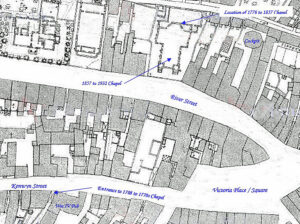
 The 1857 Bethesda Chapel
The 1857 Bethesda Chapel
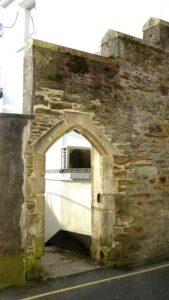 It is thought that this arch was the entrance to the site when the 1857 chapel was built but it could date from an earlier period.
It is thought that this arch was the entrance to the site when the 1857 chapel was built but it could date from an earlier period.
The new building, or rather the material used in its construction, was not to everyone’s liking and the Royal Cornwall Gazette, on Friday the 15th January 1858 included a comment from The Building News under the heading of Gothic Architecture in the Provinces:
Bethesda Chapel – We gave some weeks ago a long and interesting account of the design for the New Independent Chapel in this handsome and flourishing town; it is not necessary that we should now add anything to that description, which was sufficient to convey to the reader a complete idea of what the building will be like when it is finished. It will be sufficient for us to say here that the works are rapidly progressing, and that the design certainly promises well. There is, however, one subject on which we think it desirable to touch lightly in passing – we mean the materials which are being employed. All the dressings, it may be remembered, we stated were to be of Bath stone. Now, Bath stone is very good stone indeed, and a very desirable material at Bath, in the neighbourhood of Bath, in places like London, where good stone must be brought from a certain distance, and in parts of the country where there is no stone, and good bricks cannot be obtained, or the magnificence of the building makes it desirable to use something costlier than brick. But we must protest against introducing it into such a county as Cornwall, a county which has been, since the days of the Phoenicians, the mine of the world, and which will become, undoubtedly – when its railway communication is complete – one of the great quarries of the world. It is nothing short of downright humbug (to use an expressive word) to carry Bath stone into Cornwall. First, it is a wilful waste of money in mere carriage; secondly, it is actually inferior to stone which may be procured at a cheaper rate in the county; thirdly, the people don’t like it, and ought not to like it. Our correspondents call it “soapy”, “slimy”, and so on, and it is quite clear what they mean by the use of such strange epithets. They are proud, and justly proud, of their own stones; they know that their county contains immense supplies of good freestone, and an absolutely inexhaustible supply of that magnificent material – the finer sorts of granite, and they cannot bear to see a more effeminate material than their own brought down among them; it sets their teeth on edge to hear the scraping of a comb instead of the sharp clear sound of the broad iron chisel, struck by a weighty mallet and knocking away splinters of white glistening stone till a surface as smooth as glass grows up mysteriously under the rough but well-measured strokes, which all the combs in the fair city of Bath could not even scratch. We say then fearlessly, and because we must not leave off fighting in the battle which Scott and others are continually waging against the growing fancy for despising the natural materials of a district, and sending to a distance for an article often inferior, and whose only recommendation is the miserable one of novelty – we assert, with all boldness, that it is a positive error, which generally meets with deserved failure, to lose sight of local capabilities, and to send two or three hundred miles away for a pair of crutches for a strong giant, sound in every limb, and who must be regarded as a very model of patience, indeed, if he does not kick them in pieces when they are offered to him.
The opening of the new Independent Chapel took place, and a report of the event was included in Lake’s Falmouth Packet and Cornwall Advertiser on Saturday the 19th June 1858. It stated that the building was in the Gothic style of the period known as Early Decorated and had seating for about 600 people. It was opened on Thursday morning the 17th by the Rev. H Allon, of Islington and it was said that there “was a very numerous and respectable congregation present, including ministers and ladies and gentlemen from different parts of the county, as well as from Truro”. The Rev. Robert Panks, the Independent minister at Truro, opened the service with prayer, and then gave out a hymn which had been composed and sung on the occasion of the opening of the first Bethesda Chapel. The old chapel had been opened on the 10th of June 1776, eighty-two years previously.
A collection was made which amounted to approximately £21. The Rev. Panks stated that the building had cost about £2,000, of which £1,700 had been already received. More than £1,300 of this had been received from friends in Truro including, £200 from a bazaar, £150 from a chapel building fund in London and about £200 from Bath, Bristol, and other places that the Rev. Panks had visited.
The Royal Cornwall Gazette of the 25th June 1858 also gave a report of the chapel opening ceremony including this additional information:
The Building Committee have met since the opening and find the works, including all extras for gas, furniture etc., to have cost £2,043. 12s. 11½d to meet which the sum of £1,775. 10s. 4½d is already received or at once available, leaving a deficiency of £268. 2s. 7d. and they resolved at their next meeting to adopt some plan for its payment. They also expressed great satisfaction with the architects, Messrs Habershon of London and agreed on presenting a written testimonial to their agent, Mr Knight for the attention, skill and taste he has manifested throughout the progress of the building, during which time he has acted as clerk of the works.
We are not sure how long the Rev. Panks was in post but he clearly played a big part at a very important period in the church’s history. The Rev. John Bonsor followed him, sometime around 1860, and his incumbency was equally memorable but for entirely different reason. An episode involving him was disturbing for the congregation and notable because it was destined to reverberate around Truro for some time.
Bethesda Independent Chapel Truro – Minister Convicted of Assaults
In July 1865, the Rev. John Bonser, the minister of the Bethesda Independent Chapel, Truro, appeared at Truro Police Court, to answer two summonses of assault. It was alleged that on Sunday afternoon, the 9th of July, he unlawfully assaulted Mr Samuel George Richards, a shoemaker of St Nicholas-street, Truro, and Mr Samuel H Reed of the Cornwall Railway. They were teachers at the Sunday school connected with the Bethesda Chapel. Mr Marshall appeared for the complainants (Mr Richards and Mr Reed), and Mr J R Paull for the defendant (the Rev Bonsor). The magistrates present were the mayor (Mr J Reynalds), Mr W P Chappel, Mr S Pascoe, and Dr Barham.
It was said that owing to the disputes and misunderstandings which have for some time existed between the minister and many of the members of the chapel, the case excited a great deal of interest, and the Town Hall was crowded by members of the congregation of that and other dissenting places of worship, and the general public.
The case involved long and detailed legal points and judgement was eventually given against the defendant, the Reverend Bonsor. He was fined the sum of five pounds (equivalent to about £700 in 2022).
The Royal Cornwall Gazette of Friday the 21st July 1865 provides a comprehensive account of the case, a copy of which can be obtained on request from the author of this article.
Unfortunately, the acrimony did not end with the conclusion of the case and in the Royal Cornwall Gazette of Friday the 4th August 1865 we read that the “unfortunate state of conflicts” between the Rev. Bonser and sections of his congregation was ongoing with protests outside Bethesda and with some members of the congregation worshipping elsewhere.
Looking Back – Vivid Glimpses of Cornish History
(From the West Briton and Cornwall Advertiser of Monday the 17th October 1960)
In this series, Mr H L Douch records that on the 6th August 1865, the Rev. Bonser was still in command of Bethesda Chapel but that the congregation were worshipping in the Town Hall. The trustees had consulted their solicitor, Mr Hearle Cock, and on his advice, they issued a notice to each member. “We hereby give notice that a meeting of the Trustees and Members of Bethesda Chapel will be held at the Council Chamber on Friday the 18th inst. at 8 o’clock in the evening for the purpose of considering and deciding on the course to be pursued in consequence of the conduct of the Rev. John Bonser, as minister of the said chapel.” A committee of management was set up to decide on their next course of action.
The Rev. Bonser, still supported by Messrs Paddon and Broadley who had stood by him throughout, decided that “this Christian Church deems it necessary to appoint fresh officers to conduct the services of the Sunday school in connection with the Christian Church and hereby appoints its pastor to be the Superintendent and Mr Robert Dixon to be the secretary, pro tem.”
This was clearly inflammatory, and three trustees and 34 members of the breakaway congregation met in the Council Chamber. Arising from this was a notice to the Rev. Bonser to quit the pastorate. If he refused, their solicitor was instructed to take the necessary steps for obtaining an injunction from the Court of Chancery. Mr Cock duly filed the bill in Chancery. In spite of this, it was not until the 28th April 1866 that the Rev. Bonser offered to resign on condition that proceedings were stayed and each side paid their own costs. In his letter of resignation, he ended by saying, “In order to put an end to a system of frivolous negotiations, I have decided to retire from the contest and resign the pastorate which I have held for the last five years and a half”. In the letter he referred to himself as your “persecuted and injured pastor during the last fifteen months”.
On their return to the chapel the members of the congregation found it in good order and the Rev. Richards of Birmingham preached to a large number at a service on the 20th May 1866.
At last, matters had been resolved and about a month later when Mr Whetter, the senior deacon, was in the chair, it was resolved “that the best thanks of the church and congregation be tendered to the Mayor for his kindness in allowing them for such an extended period the use of the Town Hall in which to conduct their religious services during the time they withdrew from their own place of worship, and that, the Deacons be requested to convey to his worship the assurance that the sympathy manifested by him in the trying ordeal through which they, as a church, had to pass will ever be held in grateful remembrance”.
In December 1866 the search for a new minister was underway. It was thought inadvisable to invite the Rev. J Haisant who had been preaching for the last four weeks. A report suggests that such an invitation would not be universally popular.
During the following month, Mr Broadley, who had been one of the few supporters of the Rev. Bonser, sought and was granted readmission. He concluded his apology with: “I have now to express my deep sorrow for having thus acted and grieve to think that I should have been so far misled by the specious misrepresentations of those who ought to have known better. I have now to crave the forgiveness of the Church and of each member thereof individually to whom I have been the means of giving a minute’s pain, and trust that for the sake of ‘Him who hath forgiven us’ they also will forgive me.”
In March 1867 it was proposed that Mr Champness of Spring Hill College, be invited to serve as minister “provided he will agree to leave at three or six-months’ notice upon a majority of two thirds of the church expressing its wish to that effect”. Previous experience was clearly very much in mind. Mr Champness, however, declined to accept “on account of want of unanimity”.
In June the Rev, W Curie was invited to take up a two-years appointment, but he cited advice received as the reason that he was “forced to relinquish all thoughts of taking up his residence in Truro”.
In December 1867 it had been well over a year since the Rev. Bonser had left and the members of the church must have been pleased to finally appoint a new minister. The Rev. T Anthony of Bury St Edmunds was inducted at an annual salary of £180. Church affairs then returned to some sort of normality and the minute book contains reports of fewer problems.
As a final reminder of the conflict ever-present in the minds of the members of the Bethesda Church, and as a farewell to the Rev. Bonser, it seemed apt to quote from the foundation declaration in 1770. “From that time [the death of the Rev. Samuel Walker] we continued to meet together for reading sermons, prayer and singing which, through the Divine Blessing, we have often found advantageous and comfortable. But at last, being convinced that a preached Gospel is the great ordinance of God for the calling in and building up His Saints, and that the Great Head of the Church ordinarily and chiefly makes use of this means in all ages, we determined (looking to Christ for direction and blessing) to endeavour by every possible way in our power to obtain the Gospel in the public ministration thereof”.
This was clearly a painful episode in the life of the church but on Thursday the 19th December 1867 the Royal Cornwall Gazette reported that with the appointment of the Rev. Thomas Anthony, the recollections of the painful circumstances connected with the departure of their late minister was dying away.
In the Royal Cornwall Gazette of Thursday, the 15th April 1869 it stated that Bethesda Chapel was being enlarged and the Tregear Water Committee recommended that Mr Brewer, the contractor, be given permission to excavate the side of the road adjoining to improve the drainage. There was to be a nominal rent of one shilling per year to prevent the trustees establishing a right. They also recommended an improvement be made to the leat adjoining the bottom of the field belonging to Mr Collins and the Council, “by which the pathway could be very considerably widened in a narrow part, an objectionable curve lessened”.
Later in that year an explosion at Bethesda must have caused panic and fears that the chapel could be lost. The Royal Cornwall Gazette of Saturday the 6th November reported that “an explosion of gas took place in the new schoolroom of the Bethesda Chapel”. It seems that for the first time since the completion of the school and classrooms, and various improvements in the chapel itself, the new gas installation was “fired up”. Soon after there was an explosion (some said there were three successive explosions) in the large schoolroom. The room was damaged and the mouldings and considerable areas of plaster were dislodged. It seems that some old piping had not been secured and there were accusations of negligence. Fortunately, however, no one was hurt although one of the gas men “was turned over by the explosion”.
 1873 Survey of River Street (map provided by Susan Coney)
1873 Survey of River Street (map provided by Susan Coney)
We do not know how long the Rev. Anthony remained at Bethesda but sometime around 1876, the Reverend W H Fuller was appointed minister to the Congregationalist Chapel. From the Royal Cornwall Gazette of Friday, the 15th October 1886 we can determine his period of office as it was reported that the congregation “held a conversazione in the schoolroom for the purpose of bidding farewell to the Rev. W H and Mrs Fuller, the former of whom had been pastor of the church for about ten years”.
In 1894 it was felt that the Baptist and Congregationalist movements should work closer together, perhaps to unify, and the Royal Cornwall Gazette of Thursday the 19th July 1894 reported that “Closer relations between the two movements were being explored”. Clearly, however, the idea did not progress at this time.
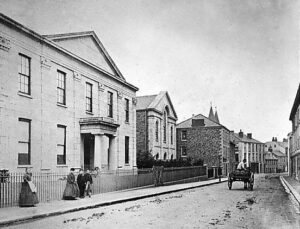
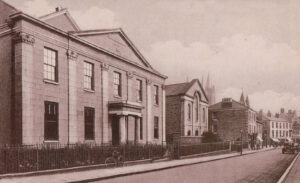 Two views looking down River Street with the pinnacles of Bethesda Chapel appearing above the rooftops
Two views looking down River Street with the pinnacles of Bethesda Chapel appearing above the rooftops
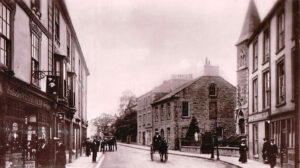 River Street with W H Smith on the left and Bethesda Chapel and Truro Liberal Club on the right
River Street with W H Smith on the left and Bethesda Chapel and Truro Liberal Club on the right
The Rev A Baker from London was appointed Senior Free Church Minister of Truro Congregational Church in 1907 and remained in post for about five years. His resignation was reported in Lake’s Falmouth Packet and Cornwall Advertiser of Friday the 19th January 1912 when he was described as a popular pastor. He was to “preach for the last time in the city on the 17th March” after which he “will probably return to the Metropolis”.
Discussions about closer working between the Truro Baptist and Congregationalist movements finally concluded in 1920 with a formal proposal that they should worship together. The stated reason was economic, but we wonder if it was also due to falling numbers at one or both chapels. The West Briton and Cornwall Advertiser of Thursday the 6th May 1920 reported on the annual meeting of the Cornwall Baptist Association which was held at Truro with the Rev. M L Murphy of Falmouth presiding. Mr H T Pearson, deacon of Truro Baptist Church, reported on the progress made regarding the amalgamation and made it clear that the proposal had been made “simultaneously from each side”. Several meetings had been held to discuss the matter and the members of the Baptist Church were “willing that the amalgamation should be brought about”. In what must have been a difficult decision for the Baptist congregation, “it was suggested that the Baptist Church should be discarded for worshipping purposes, and to unite for worship in the Congregational Church, as the better premises”. The deacons were instructed to proceed with the necessary terms of agreement, and it was hoped that as the Truro Congregational Church was currently without a pastor, the Rev. T R Lewis, pastor of the Baptist Church, would be invited to accept the pastorate for four years. Mr Pearson did not think they were asking too much as their members would form the major part of the congregation and some felt they were giving up a good deal in leaving the place where some of them had worshipped from childhood.
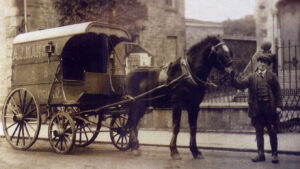 A J Mansell Machine and Steam Bakery wagon stands outside Bethesda Chapel (A J Mansell was my gt grandfather)
A J Mansell Machine and Steam Bakery wagon stands outside Bethesda Chapel (A J Mansell was my gt grandfather)
It is unclear to what extent the amalgamation proposal was put in place but if it was, then the congregation moved back to the Baptist Chapel when Bethesda Chapel closed in the early 1930s. Why Bethesda closed we cannot be sure but chapels of various denominations were beginning to close due to falls in the size of congregations and it is possible that this also applied here.
Truro Rural District Council Offices
On Thursday the 9th November 1933 the Cornishman newspaper reported on a new and secular use for the building: “Truro Chapel to Become Council Chamber”.
Truro Rural Council had purchased Bethesda Chapel, including the organ and fittings, for £2,000. It was to become the Council Chamber and Committee-rooms. The full Council had endorsed the action of the sub-committee in provisionally entering into a contract to purchase the building. Mr Coulter Hancock, the clerk to the Council, reported that an expert had been appointed “to get out a scheme to alter the premises to the most useful purpose of a Council Chamber, committee-rooms, accommodation for the staff, etc., and the estimate of the cost was approximately £1,000”. The organ and a lot of the fittings were to be sold and the proceeds would go towards the cost.
Sadly, the ornate chapel façade of Bethesda disappeared. The building was adapted and in 1935 its conversion from religious to civic was compete. It had become the offices of Truro Rural District Council.
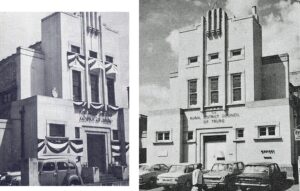 Truro Rural District Council offices with its new façade
Truro Rural District Council offices with its new façade
It appears from the photographs that, apart from the front elevation, the exterior of the building remained the same. I can certainly remember visiting the offices but had no idea that I had entered what had been a religious building.
Nothing is for ever and on the 1st April 1974 Carrick Council was created under the Local Government Act 1972, taking its name from Carrick Roads, the section of river into which the Fal, Penryn and Percuil rivers lead. This signalled the end for a number of councils and the Truro Rural District Council offices closed.
This was the final demise of the building known as Bethesda Chapel, and Cornwall Heritage Gateway records: “Site of C19 Bethesda Chapel – now demolished”.
Since then, the site has had a commercial purpose with no hint of what had previously occupied it.
 2022: The re-developed site of Bethesda Chapel / Truro RDC offices
2022: The re-developed site of Bethesda Chapel / Truro RDC offices
Further information relating to Bethesda Chapel can be found at Kresen Kernow:
23 Sep 1845: Conveyance in fee, land in River Street, Truro.
1873: Conveyance in fee, land with Bethesda meeting and dwelling house, Truro.
1873: Appointment of new trustees, plot of land with Meeting House, Truro.
1873: Appointment and demise, plots land, Truro.
1873: Appointment of new trustees, land in River Street, Truro.
1895 to 1909: The Minutes of the Congregational Church Council, Truro, 1895 to 1909 are held at Kresen Kernow Ref. X682/136.
1901 to 1924: The Minutes of church meetings at the Bethesda Congregational Church, Truro, 1901 to 1924 are held at Kresen Kernow Ref. X682/137.
1915 to 1925: The Minutes, of the Congregational Church Council, Truro, 1915 to 1925 are held at Kresen Kernow Ref. X682/138.
1924-1925: Correspondence, purchase of manse for Truro minister at Pyrmont, Carvoza Road, Truro. Letters about purchase of manse for Truro minister at Pyrmont, Carvoza Road, Truro. (Kresen Kernow X682/174)
1925 to 1930: The Minutes of the Congregational Church Council, Truro, 1925 to 1930 are held at Kresen Kernow Ref. X682/140.
1933: Correspondence regarding the sale of Bethesda Church, Truro, to Truro Rural District Council. (Kresen Kernow X682/172)
1924 to 1934: The Minutes of church meetings, Bethesda Congregational Church, Truro, 1924 to 1934 are held at Kresen Kernow Ref. X682/139.
1933-1934: Correspondence, closure of Congregational Church, Truro. Letters about closure of Truro Congregational Church to Mr H S Endean. (Kresen Kernow X682/175)
Other related documents held at Kresen Kernow:
Church Accounts.
Manse Accounts.
Baptism Records.
Grant Applications for various Congregational Churches.
End notes:
- Cockfighting is an age-old practice in which two or more specially bred birds known as gamecocks, are placed in an enclosed pit to fight for the primary purposes of gambling and entertainment.
- Calvinism is a major branch of Protestantism that follows the theological tradition and forms of Christian practice set down by John Calvin and other Reformation-era theologians.
- The Countess of Huntingdon’s Connexion is a small society of evangelical churches, founded in 1783 by Selina Hastings, Countess of Huntingdon, as a result of the Evangelical Revival. For many years it was strongly associated with the Calvinist Methodist movement of George Whitefield.
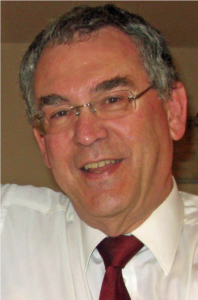
Tony Mansell is the author of several books on aspects of Cornish history. In 2011 he was made a Bardh Kernow (Cornish Bard) for his writing and research, taking the name of Skrifer Istori. He has a wide interest in Cornish history and is a researcher with the Cornish National Music Archive and a sub-editor with Cornish Story – an Institute of Cornish Studies initiative.

Much enjoyed Tony!!